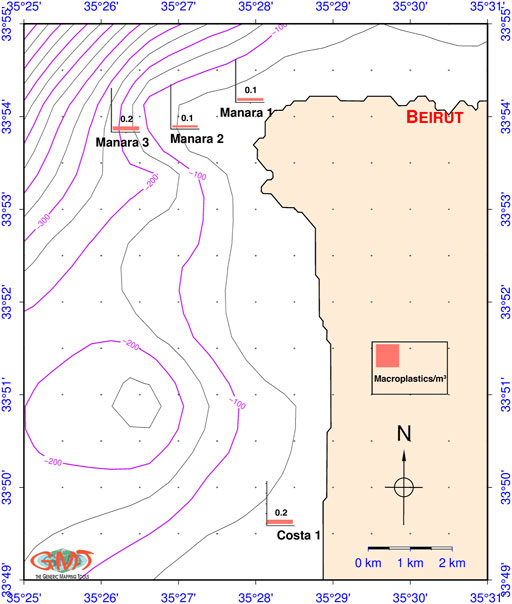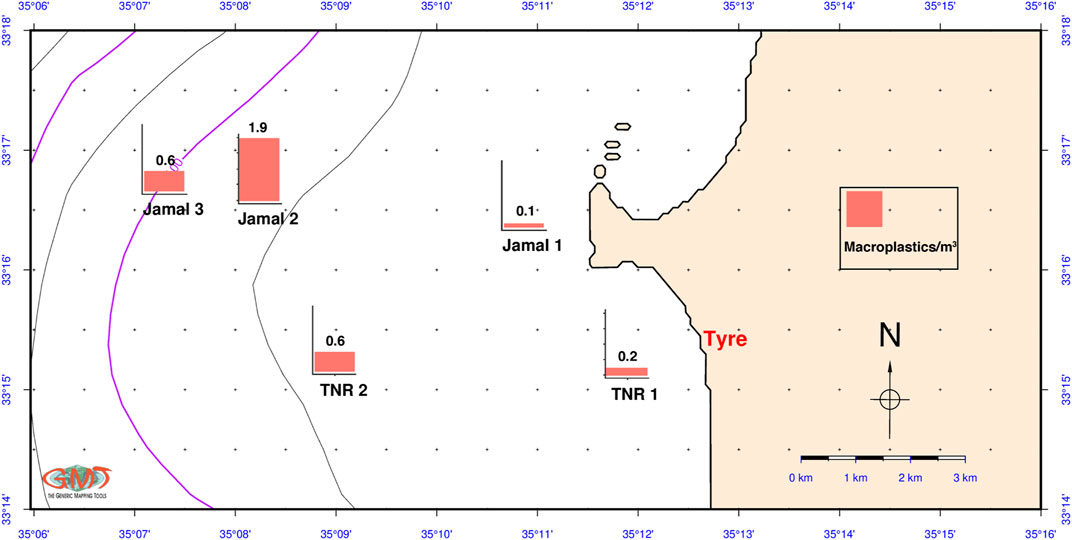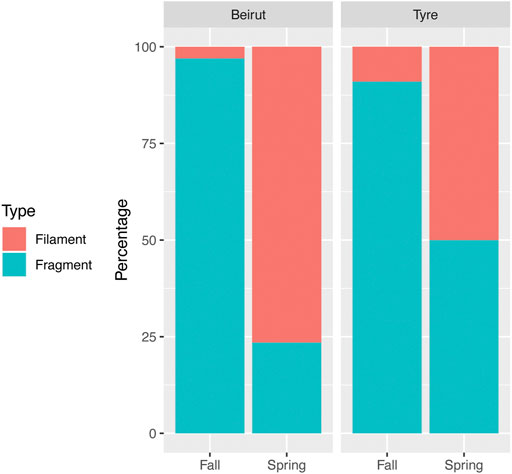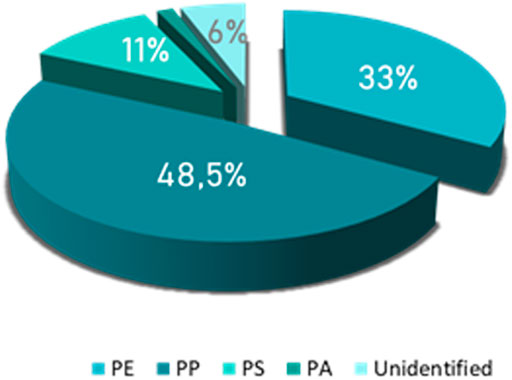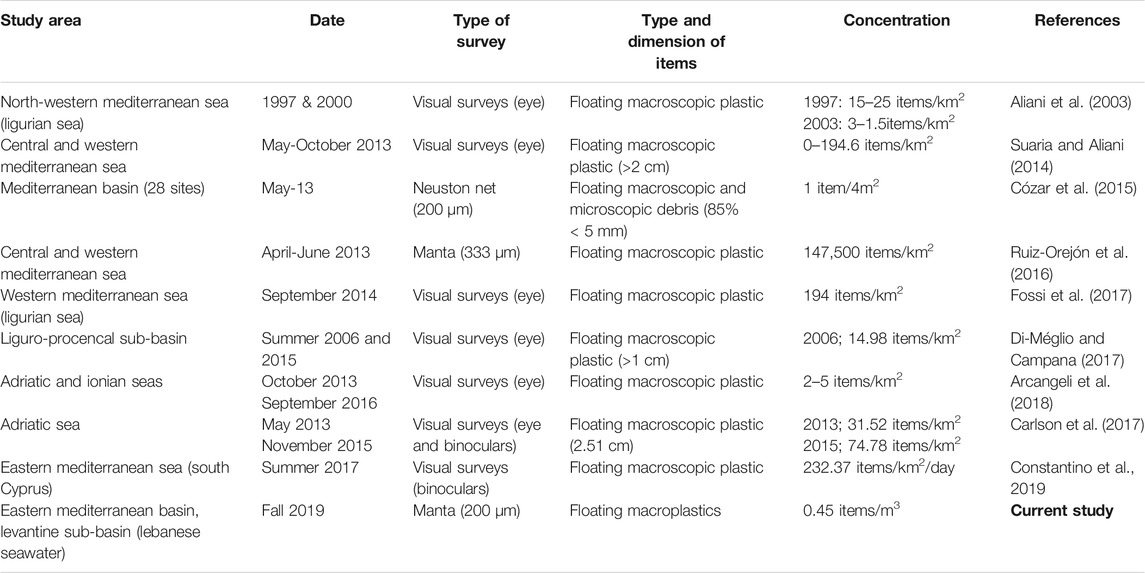Floating Marine Litter in Eastern Mediterranean From Macro to Microplastics: The Lebanese Coastal Area as a Case Study
- 1National Centre for Marine Sciences, National Council for Scientific Research in Lebanon (CNRS-L), Beirut, Lebanon
- 2Laboratoire D’Océanologie et de Géosciences (LOG), CNRS, Univ. Littoral Côte D’Opale, Univ. Lille, UMR 8187, Wimereux, France
Despite emerging and increasing concerns related to marine micro and macroplastics, no systematic surveys have been undertaken yet in the Lebanese marine area. To understand the spatio-temporal variation of plastic litter (macro and microplastics) in the Lebanese marine environment and to determine the sources of pollution, this study investigated the characteristics of plastic pollution in sea surface waters during wet and dry seasons in 22 sites of Beirut and Tyre regions. A total of 23,023 items were identified and assessed according to the shape, color, and concentration; moreover, the risk of microplastics (MPs) contamination was explored based on a risk assessment model. The obtained results demonstrated that the average macroplastics concentration was 0.45 ± 0.6 items/m3. The average microplastics concentration was found to be 20.1 ± 21.8 and 3.78 ± 5.2 items/m3 in spring and fall respectively. During fall, MPs fragments were dominant in Beirut (97%) and Tyre (91%), and no pellets were observed. During spring, filaments were most encountered in Beirut (76.5%). The most dominant marine litter color was blue followed by black and white. The Pollution Load Index (PLI) values showed a moderate contamination of the Lebanese coast with MPs (PLI: 5.79 ± 3.93) except for several sites in Beirut that showed high values of PLI, highlighting the local influence of cities and rivers on MPs concentration. This study serves as an important baseline for understanding the characteristics of the seasonal variation of MPs along the Lebanese marine environment; it will help stakeholders and countries to take proactive and reactive actions to face plastic litter pollution in the Lebanese coastal area.
Introduction
The Mediterranean Sea is one of the most affected marine environments with regards to marine litter (UNEP, 2015). Even though the type of litter found is highly heterogeneous, plastics are the most abundant material recorded (Cincinelli et al., 2019). According to the Marine Strategy Framework Directive TG10, marine litter is defined as any persistent, manufactured or processed solid material discarded, disposed of or abandoned in the marine and coastal environment (Galgani et al., 2010). The range and scale of impacts from marine litter can target public safety, as well as, the socio-economic and environmental sectors (Ferronato and Torretta, 2019).
The global annual production of plastics has increased substantially in recent decades, paving the way for the occurrence of more plastic litter in the marine environment (Da Costa 2017). About 80% of marine litter generation is mainly continental and enters the marine environment via multiple pathways, such as, rivers and discharged wastewater (Alomar et al., 2016; Kazour et al., 2019).
Among many different types of marine litter, plastic is considered the most harmful to the marine environment and wildlife (Barnes et al., 2009). One of the most appreciated qualities of plastic products is their durability and corrosion resistance (Rios et al., 2010; Szeteiová, 2010). However, these qualities when combined with improper waste management leads to environmental contamination, and impacts terrestrial, freshwater and marine ecosystems. More than an estimated 80% of the total pressure in marine waters comes from land, while 20% comes from the sea (Jambeck et al., 2015). Single-use plastics account for around 50% of total plastics production (Xanthos and Walker, 2017); hence, the packaging sector produces the highest pressure followed by the construction (Boucher and Friot, 2017; Abalansa et al., 2020), and then the agricultural sector. In addition, the combined pressures from sea-based fisheries and aquaculture represent the fourth most important economic sector in terms of pressure on the marine ecosystem (Boucher and Friot, 2017; Charter et al., 2018). Finally, the tourism economic sector, related to the use of beaches, has been reported to increase pressure by 40% in the Mediterranean region every summer (Galgani et al., 2010; Murani et al., 2016), taking into consideration that the surrounding countries annually attract about one third of the world tourism (WTO, 2018).
Once in the ocean, plastic tends to stay at or near the surface where the photo-chemical, mechanical and biological processes degrade large items into smaller fragments (less than 5 mm), forming what is called as “microplastics” (Thompson et al., 2004; Andrady, 2011; Isobe et al., 2014). Microplastics (MPs) can result either directly from synthetic fabric residues and cosmetic products (i.e., industrial pellets and scrubbers) or from the breakdown of larger plastic products generating fragments or fibers (Arthur et al., 2009; Browne et al., 2011; Hidalgo-Ruz et al., 2012; Cole et al., 2013). Particles with a density that exceeds that of seawater (1.02 g/cm3) will sink and accumulate in the sediment (Woodall et al., 2015), while low-density particles tend to float on the sea surface or in suspension in the water column (Fossi et al., 2012; Suaria and Aliani, 2014). However, the main threat of microplastics floating on seawater is the possibility of ingestion of their ingestion by species of commercial importance for fisheries and aquaculture, which can obstruct the digestive tract and limit the entry of food, consequently leading to malnutrition for the animal (Wright et al., 2013; Ivar do Sul and Costa 2014; GESAMP, 2016; Karbalaei et al., 2018; Kazour et al., 2019; Xiong et al., 2019). In the marine environment MPs are referred to the ‘cocktail of contaminants’ due to their association with additives; hence, their ability to reach biota and human (Rochman, 2015; Hartmann et al., 2017). Two important seafood species (European anchovy, Engraulis encrasicolus, and the spiny oysters, Spondylus spinosus) that are wholly consumed by the Lebanese community have high presence of MPs which highlights the potential risks that MPs might have on the biota. The risk of MPs in the environment has been previously assessed using the pollution load index (PLI) (Peng et al., 2018; Liu et al., 2019). But such assessment remains difficult to determine due to the environmental influences and the absence of a standardized method to monitor MPs in the environment (Hidalgo-Ruz et al., 2012). In addition, PLI has been not assessed in the Mediterranean Sea yet even though this semi-enclosed sea is considered to be a hotspot for plastic contamination (Llorca et al., 2020). The Lebanese coast is affected by a wide range of anthropogenic pressures. Urban sprawl and pollution from wastewater effluents, including river discharges, appear to be the most severe and permanent problems of the coastal zone (UNEP ERML, 2012). In addition, the presence of numerous mismanaged open-air dumpsites and landfills along the coast point out their potential contribution in MPs entry into the marine environment (UNDP, 2017; Kazour et al., 2019). In the Eastern Mediterranean, studies related to marine litter and microplastics in marine waters are relatively scarce for their environmental and social costs (Özden et al., 2021). Such studies are deficient along Lebanese coast, with the exception of a recent study that highlighted the presence of high levels of microplastics in surface waters and sediments compared to other Mediterranean regions (Kazour et al., 2019). Therefore, a baseline study assessing a significant number of samples and covering more seasons is necessary to have an overview of plastic debris and its variations in surface waters along the Lebanese coast. Hence, the present study aims 1) to quantify marine litter in coastal areas under a gradient of anthropogenic pressures from populated coastal zones to Marine Protected Areas and the assessment of spatial differences, 2) to evaluate the MP risks, and 3) to provide a science-based knowledge for the management of marine plastic litter in the Lebanese marine water, in the context of the UN Sustainable Development Goal 14.1 (SDG 14.1).
Materials and Methods
Case Study Sites
Surveys for marine litter were conducted onshore and offshore sites near Beirut and Tyre along the Lebanese coast. Beirut, the capital, is the most urbanized and industrialized area (population ≈2.4 million according to the World Population Review 2021). It is subject to high coastal pressures due to the presence of the Beirut port, three coastal landfills and numerous sewage outfalls. The capital suffers from solid waste problems, as there are many mismanaged coastal dumpsites polluting the coastal area. In addition, various effluents such as industrial discharges and wastewater from inhabited areas drain along by Beirut River and Antelias River, and are discharged directly into the sea. Tyre region does not suffer from the same anthropogenic pressure (population ≈ 200,000 according to the Lebanese Population - Central Administration of Statistics (CAS, 2014)), despite being the fourth densest coastal city in Lebanon. It is considered to be less polluted due to the lack of industrial activities in the region along with the presence of the Tyre Coast Nature Reserve (TCNR).
Sampling of Marine Litter
Sampling and analysis of macro and microplastics were carried out by the National Centre for Marine Sciences in Lebanon (CNRS-L). Samples were collected from 22 marine sites using a Manta net (W 60 cm x H 26 cm rectangular frame opening; 2.6 m length and net mesh size 200 μm) that was towed with a 7 m catamaran for 10 min at a speed of 3 knots and in low wind conditions (less than 0.4 miles/s as suggested by Kukulka et al., 2012). The number of items for each site is presented in Table 1.
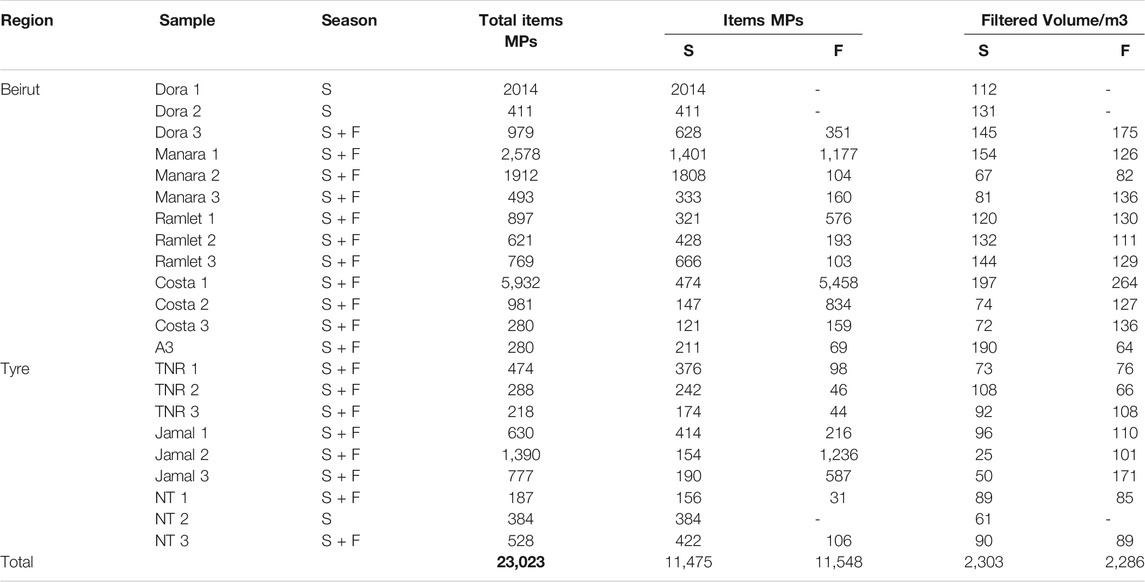
TABLE 1. The number of items identified and the volume of filtered water for each site during spring and fall (MPs: Microplastics; S: Spring; F: Fall).
Start-end position points were recorded on GPS. All tows were conducted from the ship's side and beyond the ship's wake. After completion of each tow, the net was washed thoroughly with seawater in order to collect all particles in the cod end (Zeri et al., 2018). The collected water in the cod end was transferred in glass jars containing 70% ethanol solution and were stored in a cooling box until further processing. In the laboratory, the samples were filtered on a stainless-steel sieve of an 850 μm mesh-size. Macroplastics were extracted and rinsed with filtered distilled water and the MPs present on the sieve were sorted visually under the stereomicroscope. In order to extract the MPs fraction below 850 μm, the recovered water was vacuum-filtered on GF/A filters and conserved inside a clean glass Petri dish. The solutions of hydrogen peroxide (H2O2) and zinc chloride (ZnCl2) were used to eliminate organic material (prior to microscopic observation and counting) and separate MPs, respectively (Guven et al., 2016; Kazour et al., 2019).
Microplastics were counted and photographed under a dissecting Stereomicroscope (Carl Zeiss, Stemi-305, Germany) equipped with AXIOCAM 105 color 5 MP. Photos were taken and processed with Zein platform (Image Analysis software). When observing particles, the filter inside the glass Petri dish was moved in a “zigzag” pattern from left to right. Microplastics particles were visually identified and assessed based on their shape, color and size (Cózar et al., 2015; Kazour et al., 2019). Two shapes of microplastics were observed: filament and fragment. Based on different colors, microplastics can be divided into ten categories: blue, black, yellow, transparent, white, grey, orange, purple, green and red.
Particles longer than 5 mm were considered as macroplastics and recorded only in fall. Several precautions were followed to minimize air-born contamination during sampling, sample preparation and analysis. Different procedures (filtration, measurements) were done under a laminar flow hood, wearing cotton lab coats. All surfaces and equipment were rinsed before usage with filtered distilled water. Only glass and stainless-steel laboratory supplies were used (Funnel, bottles, Petri dishes, Erlenmeyer flasks, filtration system) and were covered immediately after manipulation. All solutions (distilled water, H2O2 and ZnCl2) were filtered on glass fiber filters (GF/A filters, 1.6 μm porosity, Whatman, France) to eliminate unwanted particles or fibers. The contamination control procedure was followed according to the methodology mentioned by Kazour et al., 2019. During the lab work a quality control procedure was implemented using a Petri dish with distilled wather puted in the laminar flow hood were all procedure was done. After work the Petri dish were examined to make sure there is no macroplastic contamination in the working environment.
Microplastics Characterization and Identification
Visual observation often leads to an overestimation of the microplastics found in environmental and biological samples (Dekiff et al., 2014; Lenz et al., 2015). Micro-Raman Xplora Plus (HORIBA Scientific®, France) was used to identify microplastics and macroplastics observed in this study. Due to the high time consumption, a subsample that represented 1% of random suspected plastics were characterized. Identification was carried using two lasers of a 532 and 785 nm wavelengths with a range of 200–3,400 cm−1 using two objectives (Olympus):×10 and ×100 (Kazour et al., 2019). The spectra is compared using the polymer identification software (KnowItAll, WILEY®) and a personal library made with specific polymers obtained from Goodfellow (France).
Microplastics Risk Assessment Method
To assess the degree of MPs pollution in sea surface of the two Lebanese coastal regions, an integrated Pollution Load Index (PLI) was calculated based on Tomlinson et al. (1980). The PLI is regarded as a standardized rule for monitoring the degree of pollution between different areas (Angulo, 1996). Therefore, this risk assessment model is robust and applicable to better understand and evaluate the ecological risks caused by microplastics pollution (Peng et al., 2018; Xu et al., 2018; Liu et al., 2019). PLI at each site is related to MPs Concentration Factors (CFi) as given below:
CFi of the MPs is the quotient of the MPs concentration at each station (Ci) and the minimum MPs concentration (Coi). The lowest concentration of MPs value detected in this study was considered as a Coi value. PLI area was calculated for both Beirut and Tyre regions.
Statistical Analyses and Maps
The statistical software R Studio (RStudio Team, 2020) was used for all statistical analyses. In addition, all maps were built using the Generic Mapping Tools (GMT), version GMT6 using the GMT coastline database GSHHG to show the Lebanese coast features and (GEBCO, 2020) Gridded Bathymetry Data for the bathymetry contour lines (GEBCO, 2020).
A Shapiro-Wilk normality test was first used to test for the normality of the sample using the shapiro. test function. A Kruskal-Wallis rank sum test was then used to examine the differences between total microplastics concentrations by sites according to several factors, such as, season, region, and sites using the kruskal. test function.
A Principal Component Analysis (PCA) was also performed using the FactoMineR package and the PCAmix function of the PCAmixdata package. PCA provides insight into the structure of the data by synthesizing the relationships between variables. PCA was implemented on the following numerical variables: Total MPs, total filaments and total fragments concentrations and the two categorical variables (season and region) where included in the analysis as additional variables with the following modalities: the 2 modalities of season (spring and fall), and the two modalities of region (Beirut and Tyre). Results are presented on the first two principal components representing the highest percentage of the total variance. Finally, a Pearson correlation test was performed using the cor. test function to test the relationship between total MPs concentration and PLI.
Results
Macro Litter Abundance and Composition
All anthropogenic litter items were recorded but for the purpose of this study we focused only on plastics (Synthetic) which accounted for 99.2% of total collected items (Figure 1). Floating natural materials (feather, corn, hair, sticks, watermelon seeds and fruits) accounted for 0.8% of total litter items recorded. Out of the 22 transects, 13 were macroplastics-free (59%). Floating macroplastics constituted 3.7% of the plastic litter. A total of 439 plastic items (hygienic pad cover, rope, beer tag, band-aid, fishing net, agricultural plastic fragments) were visually counted and correspond to a concentration of 0.45 ± 0.6 items/m3.
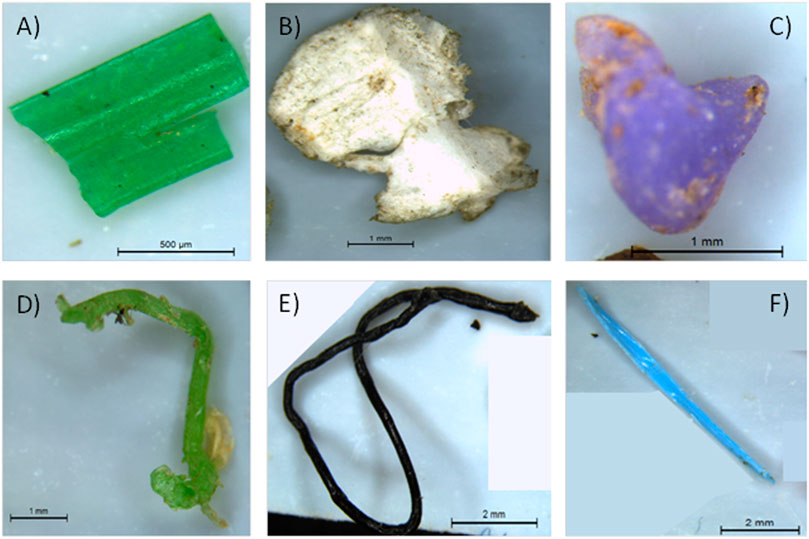
FIGURE 1. Plastics of different shapes and colors collected along the Lebanese coast (A) Green (B) White and (C) purple fragments (D) green (E) black and (F) blue filaments.
Macroplastics were observed in four marine sites of Beirut (Manara 1, 2, 3 and Costa 1), with the highest number at onshore sites (Figure 2). Macroplastics were absent in offshore samples (A3: 6 km offshore the coast). The highest concentrations were observed in Manara 3 and Costa 1 (≈1.8 items/m3) followed by Manara 1 (0.12 items/m3).
Macroplastics were observed at five sites in Tyre (TNR1, TNR2, Jamal 1, Jamal 2, and Jamal 3) with the highest number at Jamal 2 and 3 with 198 and 104 items, respectively. The highest concentrations were observed in Jamal 2 (1.95/m3) followed by Jamal 3 and TNR2 (≈0.60/m3) (Figure 3). Comparing the two regions, macroplastic items constituted 0.75 and 13.5% of the plastic litter in Beirut and Tyre, respectively.
Microplastics Concentrations and Seasonal Variation
A total of 23,023 MPs items were identified in the 22 sites and assessed according to color: black, blue, green, grey orange, purple, red, transparent, white and yellow. The number of MPs in spring and fall was 11,474 and 11,549, respectively (Table 1). Significant differences were observed between total MPs according to season, whether treating the sample as a whole or separating it regionally (All data: Kruskal-Wallis = 21.234, d. f. = 1, p < 0.05; Beirut data: Kruskal-Wallis = 10.143, d. f. = 1, p < 0.05; Tyre data: Kruskal-Wallis = 10.083, d. f. = 1, p < 0.05). In fact, the average concentration in spring and fall was found to be 20.1 ± 21.8 and 3.78 ± 5.2 item/m3, respectively. However, no significant differences were observed in total MPs concentration according to region (Kruskal-Wallis = 0.039305, d. f. = 1, p > 0.05) or within the specific region: Tyre (Kruskal-Wallis = 15.255, d. f. = 12, p > 0.05); Beirut (Kruskal-Wallis = 15.597, d. f. = 14, p > 0.05). The distribution and concentrations of microplastics in Beirut and Tyre are represented in Figures 4, 5, respectively. Except Costa 1 that showed a higher concentration in fall, all the other coastal sites in Beirut showed high concentrations during spring, with the highest in Manara 2 (109/m3) and Dora 1 (86.7 item/m3) (Figure 4). As for Tyre, no exceptionally high concentrations were observed for all sites (all sites had a concentration less 25 item/m3 during both seasons). Similar to Beirut, the highest concentrations were observed during the spring season for all sites, with the highest in TNR2 (24.8/m3), NT1 (21.5/m3), and TNR3 (21/m3).
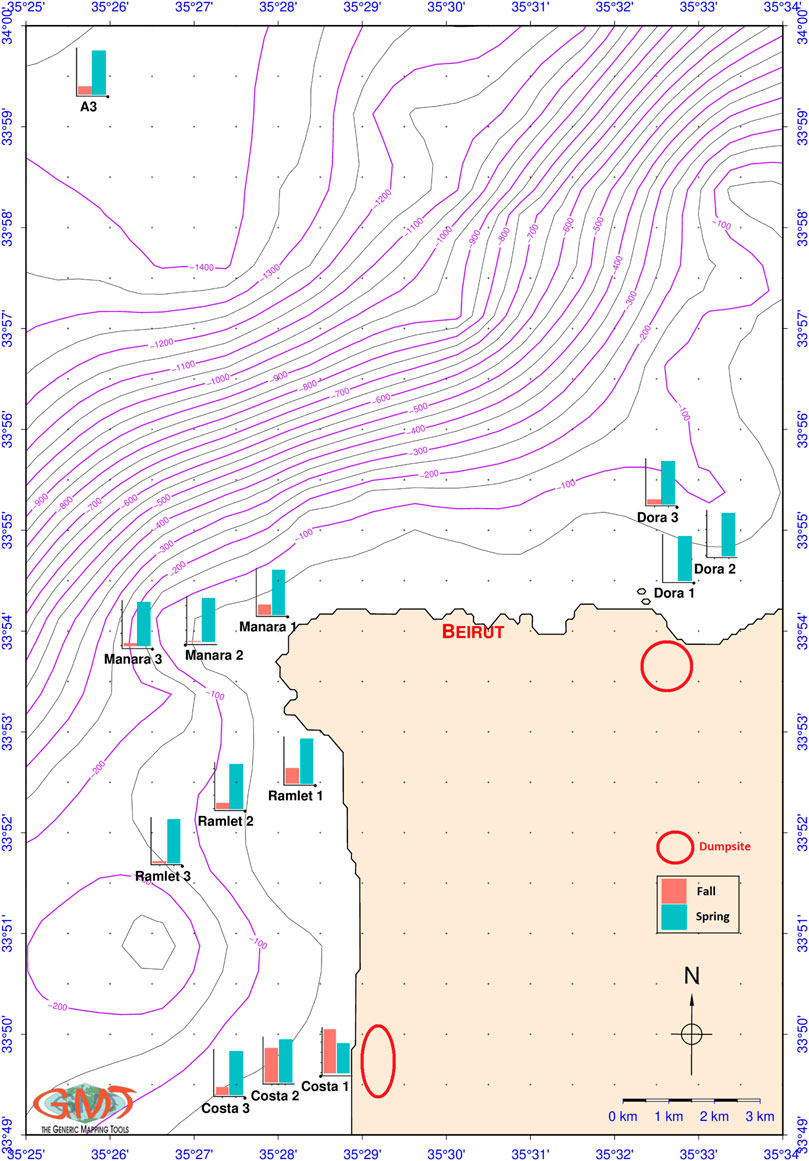
FIGURE 4. The distribution and concentration (items/m3) of total microplastics during the spring and fall seasons in Beirut marine area.
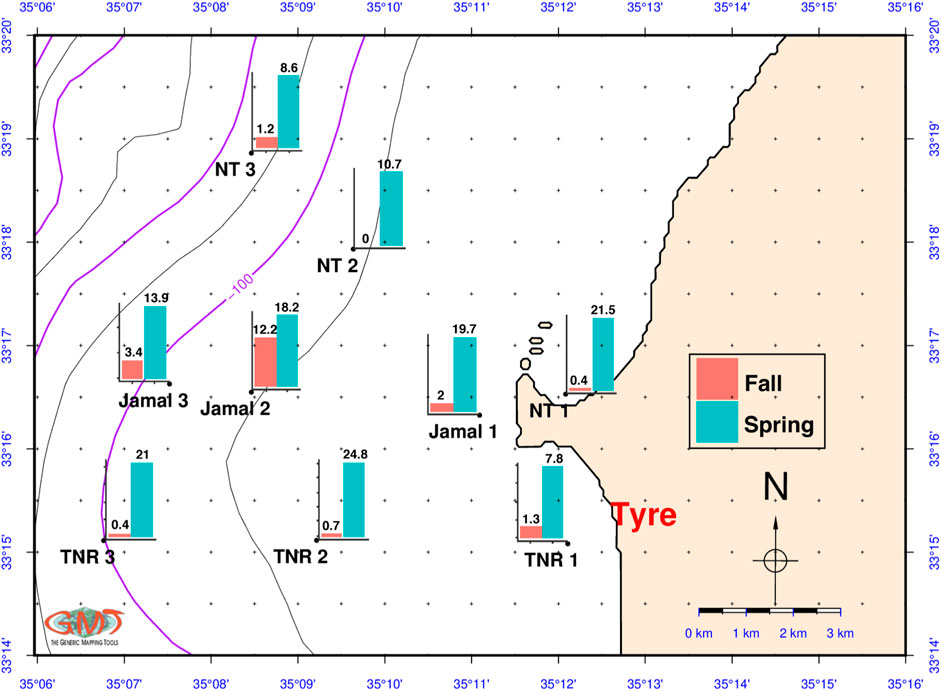
FIGURE 5. The distribution and concentration (items/m3) of total microplastics during the spring and fall seasons in Tyre marine area.
Microplastics detected in seawater samples from Beirut and Tyre were classified into two main shapes: fragments and filaments. The percentage of fragments was high in Beirut and Tyre during fall, representing 97 and 91% of the total MPs concentration, respectively. During spring, filaments dominated in Beirut with a percentage of 76.5% (Figure 6). For both areas and seasons, fragments dominated over the filaments with 65.4 and 34.6%, respectively.
To affirm previous results, a PCA was performed using total fragment and filament concentrations as numerical variables, in addition to season and region as categorical variables. Results were presented on the first two principal components representing 67.97% of the total variance The PCA showed that the main variables contributing to axis 1 (41.71%) were total fragment and filament concentrations, as well as, seasons, whereas region contributed to axis 2 (26.26%). The PCA outcomes showed that total fragment and filament concentrations (summed up to become total MPs concentration) followed seasonal variability but not a spatial one (Figure 7).
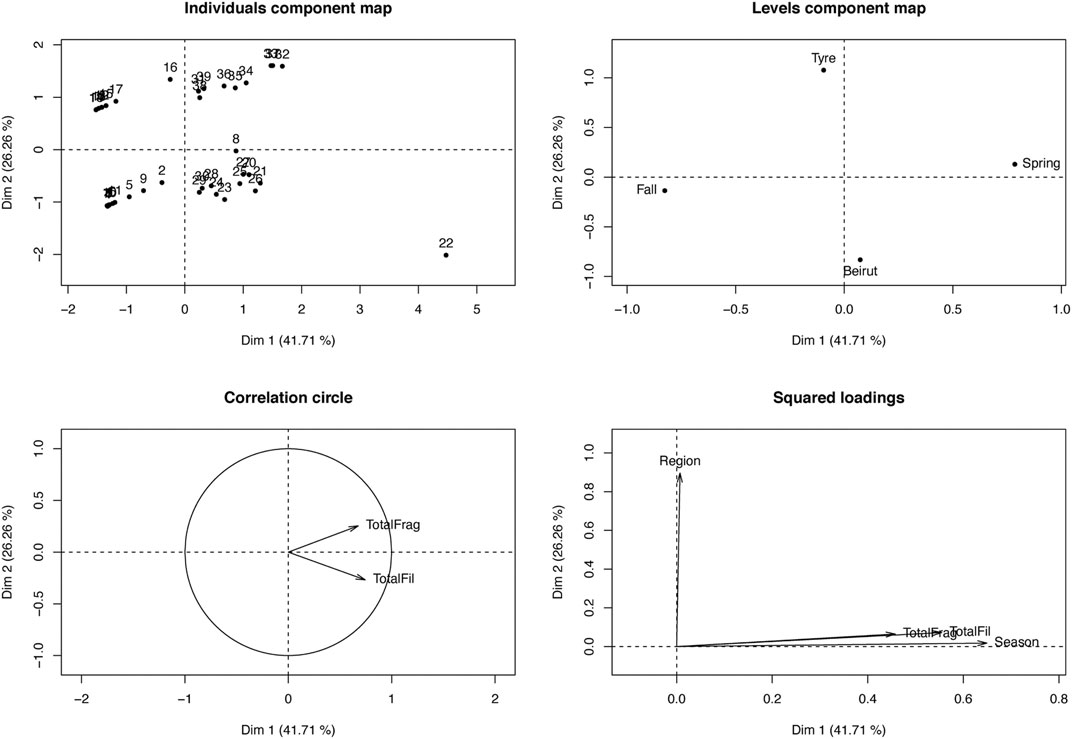
FIGURE 7. The individual and level component maps, correlation circle and squared loadings of the PCA for both Beirut and Tyre regions.
Microplastics Colors
For all microplastics observed, blue colored items showed the highest concentrations, followed by white and black colored items (Figure 8). During spring, the blue color showed a high concentration in both regions followed by black in Beirut and grey in Tyre. The lowest concentration was recorded for the yellow color during spring in both areas. During fall, there was a predominance of white color in Beirut, and transparent one in Tyre (Figure 9).
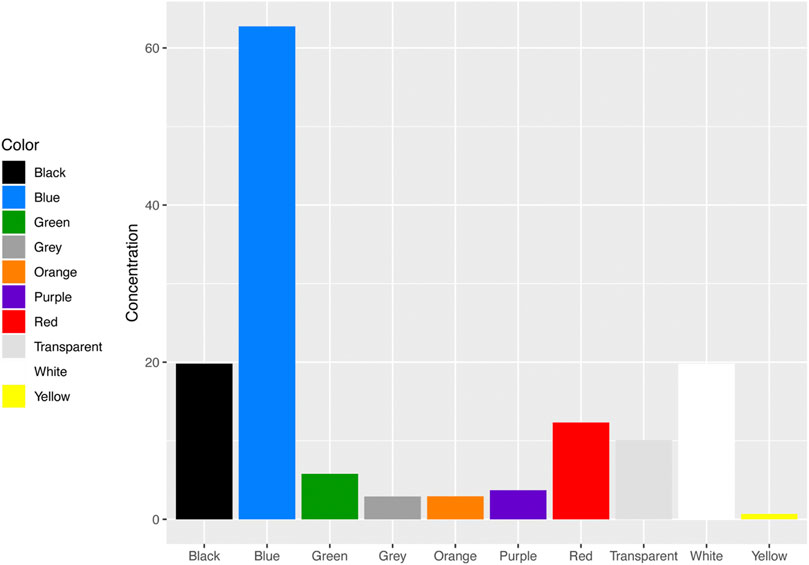
FIGURE 8. Microplastics concentration (items/m3) according to colors for combined data from the marine areas of Beirut and Tyre.
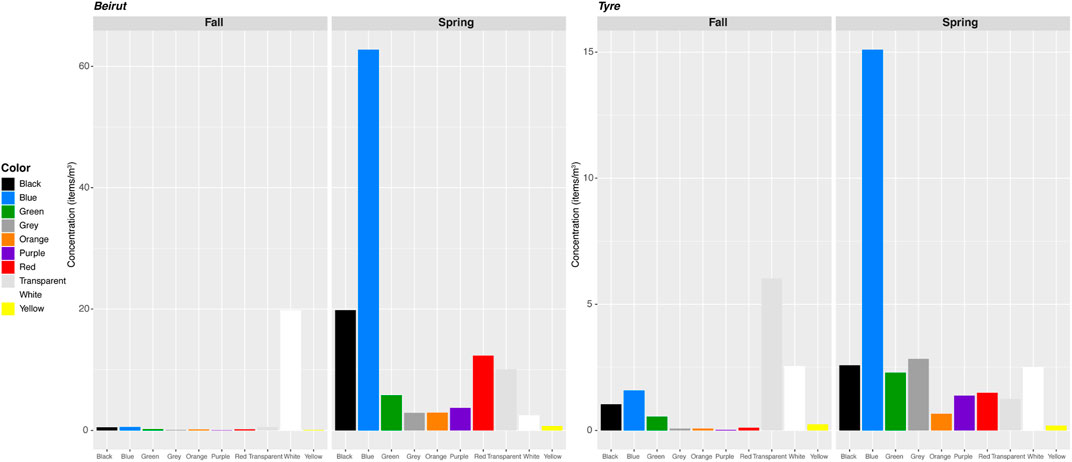
FIGURE 9. Microplastics concentration (item/m3) according to colors for the marine areas of Beirut and Tyre during fall and spring seasons.
Polymer Identification
Among the suspected plastics, 94% were identified as plastics. The other 6% were impossible to characterize and they were considered as “unidentified”. In the subsample, four types of polymers were specified: Polypropylene (PP), Polyethylene (PE), Polystyrene (PS) and Polyamide (PA) (Figure 10). The identification of colored plastics demanded a precise analysis of the dye (colorant) spectrum in addition to that of the polymers (Supplementary Figure S1). PP was the most abundant polymer representing 48.5% of the samples. Whereas PA was only found in 1.5% of the sample. These polymers constituted the two observed shapes in all samples.
Risk Assessment of Microplastics
The MPs were indexed by their concentration using the Pollution Load Index (PLI) and the results are shown in Figure 11. The PLI values of sites from Tyre region were less than 10, which indicated a minor risk category (Table 2). There was a strong correlation (94%) between total MPs concentration and PLI (Pearson rank correlation, rp = 0.94, df = 40, p < 0.01). Moreover, significant differences in PLI were also detected according to season, whether taking the sample as a whole or taking each region separately (All data: Kruskal-Wallis = 23.873, d. f. = 1, p < 0.05; Beirut data: Kruskal-Wallis = 12.893, d. f. = 1, p < 0.05; Tyre data: Kruskal-Wallis = 10.083, d. f. = 1, p < 0.05). The PLI was higher in spring than in fall for all sites in Tyre region. During spring, three sites in Beirut (Dora1, Manara1 and Manara2) showed PLI values between 10 and 20 indicating a high-risk category. A PLIarea was calculated for the two regions and showed values of 5.05 and 4.03 for Beirut and Tyre, respectively.
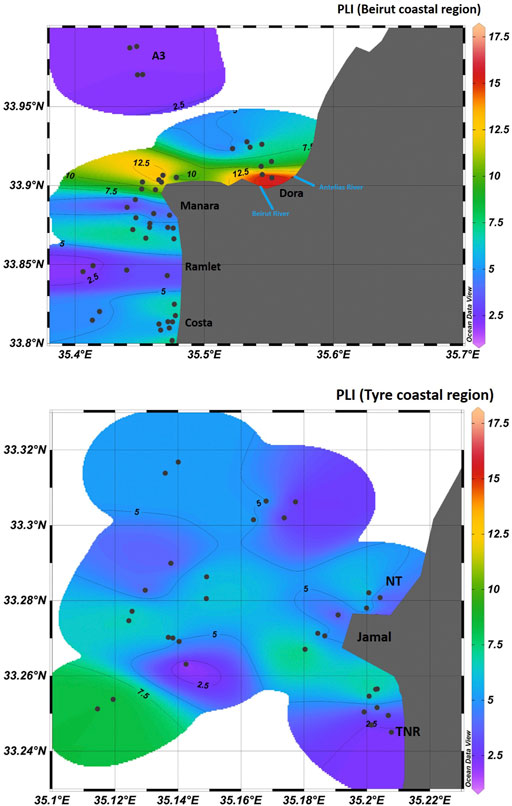
FIGURE 11. Pollution Load Index (PLI) of MPs in the coastal marine areas region of Beirut (top) and Tyre (bottom).

TABLE 2. Terminology used to describe the risk level criteria for MP pollution according to Ranjani et al. (2021) and Xu et al. (2018).
Discussion
Macroplastics Density
Floating macroplastics have been recognized as an ecological problem of global concern (Lebreton et al., 2018); however, knowledge regarding the abundance and distribution of floating objects in the Eastern Mediterranean is still limited compared to the substantial number of studies available for the Central and Western Mediterranean areas (Suaria and Aliani, 2014; Di-Méglio and Campana, 2017; Arcangeli et al., 2018; Constantino et al., 2019). Lebanon leaks into the sea a total of 3,321 tonnes/year of macroplastics compared to neighboring countries like Egypt (74,031 tonnes/year), Turkey (23,966 tonnes/year) and Cyprus (332 tonnes/year) (Boucher and Bilard, 2020). In this study, the average concentration of macroplastics in Lebanese waters (22 transects) was 0.45 items/m3. In 2018, Constantino et al., showed that the macroplastics concentration was 232 items/km2 (range 18–1,593 items/km2) in southern Cyprus, which was within the range of values reported for the Pelagos Sanctuary located in the Ligurian Sea (average 194 items/km2; range 16–453 items/km2) (Fossi et al., 2017) and the upper range of values found in Central and Western Mediterranean areas (maximum 195 items/km2) (Suaria and Aliani, 2014). According to Table 3 and due to the differences in sampling methodologies and the calculation of concentrations, macroplastics concentrations cannot be considered comparable. The most important factors affecting the distribution of macroplastics in marine waters are the vicinity to marine litter sources and pathways with high uncertainties regarding their fluxes, as well as, the specific oceanographic features prevailing in each sub-basin (Zeri et al., 2018).
Microplastics Concentration and Polymers Abundances
The MPs concentration recorded for the Lebanese marine environment in this study (12.13 items/m3) was more than 2-fold higher than the one recorded in 2018 (4.3 items/m3) (Kazour et al., 2019). This concentration was also higher than those recorded in the surface waters of the South-East Levantine sub-basin (7.68 items/m3) (Van der Hal et al., 2017) and Iskenderun Bay (7.26 items/m3) in the northeastern Mediterranean (Gündoğdu, 2017). The MPs concentration in Lebanese seawater is also higher than that recorded in the Gulf of Asinara-Sardinia (Western Mediterranean), Ligurian Sea (western Mediterranean), and the Turkish Mediterranean coast (Table 4). The heterogeneity of the MPs concentrations and distribution levels may be linked to multiple factors, such as, sampling methodologies, digestion and density separation.

TABLE 4. Literature data showing MP average density in items/m3 in different regions of the Mediterranean Sea.
In this study, the high concentration of MPs during spring could be related to the seasonality effect. Rainfall during the wet season (winter) may explain these differences, as surface runoff can transport plastic litter from inland areas to streams and rivers (Shimizu et al., 2008; Ivar do Sul and Costa, 2013). Moreover, abundances and weights of plastic debris were demonstrated to be significantly higher in the wet season compared to the dry season (Cheung et al., 2016), similar to the obtained pattern in this study.
In addition, the influence of the Mediterranean Sea physical oceanographic features, such as, gyres, eddies, sea surface currents, and fronts might be the cause of heterogeneity in MPs density. In fact, the Eastern Mediterranean presented a high infestation of MPs (specifically small fragments) compared to the Western Mediterranean (Cózar et al., 2015). Grand fluxes of MPs (10–30 kg/km/day) were observed along the Levantine sub-basin coasts from Egypt to Lebanon, Syria, and Turkey (Constantino et al., 2019). The differences between the Eastern and Western Mediterranean basins are due to different circulation patterns: water currents in the Eastern Mediterranean play the role of attractors leading to the accumulation of MPs, while the currents in the Western Mediterranean promote circulation (Mansui et al., 2015). Furthermore, the complex configuration of the current circulation, with the presence of meso-scale and sub-basin scale eddies in the Levantine sub-basin could explain the distribution of MPs along the Lebanese coast (Menna et al., 2012).
Those factors can also influence the polymers distribution in our water samples. Polypropylene and Polyethylene were the most abundant types of plastics found. These two polymers are the most found in the Mediterranean Sea and are two of the greatest subsets of plastics manufactured worldwide (Geyer et al., 2017; De Haan et al., 2019). Their characteristics as flexible, lightweight and low density polymers allow them to float on the surface water (Kazour et al., 2019). They are highly used in packaging (plastic containers, bottles, films and bags), geotextiles and in fishing activities (i.e: fishing nets) (Suaria et al., 2016). The presence of Polyamide, a polymer with a higher denser of marine water (1.14 g/cm3), in our samples might be connected to the turbulent mixing and currents that lead denser polymers to persist on the surface water. Previous studies have also described the presence of polymers with a higher density than seawater (Enders et al., 2015; Suaria et al., 2016; Kazour et al., 2019). The presence of these polymers on the surface water and their potential degradation might affect the aquatic biota biological performances and induce oxidative stress (Sun et al., 2021). Due to the enormous time consuming process, the percentage of identified particles represented 1% of the total sample. Such identification percentage is similar to various microplastics studies that have thousands of suspected MPs usually analyze up to 5% of the total items (Lares et al., 2018; Gies et al., 2018; Magnusson and Norèn, 2014; 2–8%; Simon et al., 2018).
Influence of Plastic Colors on Fish Ingestion
In this study, the green and black colors were identified with the dominance of blue., Colored MPs are sometimes confused as preys and are potentially ingested by aquatic biota (Lopes et al., 2020). This ingestion occurs especially during the spring season (i.e. spawning period for most fish). and can affect the growth and development of larval fish (Lönnstedt and Eklöv, 2016). Moreover, microplastics was ingested by three anchovy species were fibers hade a highest concentration than fragments (Guntur et al., 2021).
Microplastics are frequently detected in the gastrointestinal tracts of aquatic organisms (Lusher et al., 2017). A number of active and passive pathways have been suggested for fish, including the confusion of microplastic particles with prey, accidental uptake while foraging and transfer through the food chain (Roch et al., 2020). Study of sea birds indicates that plastic particles with algae living on the surface can release infochemicals to entice the sea birds to eat them directly (Cózar et al., 2017). Sea turtles which perceive floating plastics from below, preferentially ingest dark plastic fragments (Santos et al., 2016).
Microplastics that visually resemble the natural prey are actively ingested by several fish species such as Girella laevifrons, Decapterus muroadsi. A laboratory study of palm ruff Seriolella violacea, showed that particles with similar color to artificial food pellets were more often ingested (Mizraji et al., 2017; Ory et al., 2017; Ory et al., 2018).
When the density of food was generally lower, the number of microplastics in the gastrointestinal tract increased with MPs concentration in the water (Roch et al., 2020). Particles smaller than 5 μm can pass the gastrointestinal tract wall and bioaccumulation could arise when uptake exceeds release or when particles are assimilated in tissues or organs and their effects may be significant, especially in long-living species, with implications for food web transfer and fish as food items (Roch et al., 2020). The goldfish (Carassius auratus) ingests polyethylene (PE) microplastics and these processes are affected by color, and MPs shape. However, in the presence of food, more green and black MPs were ingested compared to red, blue, and white MPs while significantly higher amounts of microplastics films were ingested compared to fragments and filaments (Xiong et al., 2019). The blue color was the most frequent in water and shrimps Paratya australiensis (Nan et al., 2020). Only one study performed in Lebanon showed the presence of filaments in the stomachs of European anchovies (Engraulis encrasicolus) constituting 1.6% of the total prey content (Jemaa et al., 2016).
The Pollution Load Index of Microplastics
Based on the PLI results (Figure 9), a total of nine sites in Tyre and Beirut showed values less than 10 (minor pollution), and three sites in Beirut showed values between 10 and 20 (high pollution). The risk within the two regions was determined using PLI zone, and the results indicated a seasonal variability in each region. It was revealed that sites with a high MPs pollution load had a high concentration of MPs. Therefore, increased MPs pollution risk is dependent on high levels of accumulation in the environment and the existence of harmful microplastics polymers (Xu et al., 2018). The highest value in Dora can be attributed to the presence of Beirut River that diverse in north of Beirut facing the sampling site. According to the assessment result of PLI, the risk pollution of MPs in surface waters of Beirut and Tyre was minor and not serious. However, the risk level of MPs pollution in Beirut was greater than that of Tyre (mean PLI: 6.33 > 5.02).
The risk of MPs pollution is not only driven by the accumulation of MPs caused by hydrological dynamics in the Lebanese marine area, but also through land-based sources like municipal wastes and coastal landfills, which increase the risk of MPs in the marine environment (Swati et al., 2017; Khalil et al., 2018; Kazour et al., 2019). The highest PLI of MPs was recorded at Dora 1 (PSI = 17; high risk level), Manara 1 (PSI = 12.7; high risk level) and Manara 2 (PSI = 19.1; high risk level) in Beirut region. The highest values of PLI can be correlated to the land-based source of MPs; for instance, Dora 1 was located near the economic harbor of Beirut (receiving ≈2,300 ships by year), the Beirut River and the Dora landfill. The highest level of PLI in Manara 2 can be related to the presence of a wastewater outflow at its proximity.
According to Plastics Europe (2020), plastic production is forecasted to increase by 4% every year. This current study highlights the presence of macroplastics and microplastics in the sea surface of Lebanon, all of which is related to the increased urbanization along the coast, currents dynamics, and other environmental factors. So far, there are no legislations that aim to manage plastic use in Lebanon, although several organizations/NGOs are working at a local scale to reduce the single use of plastics and encourage recycling. This study can help decision makers take proactive or reactive actions and face marine litter pollution in the Lebanese coastal and marine environment. However, MPs in the marine environment constitute a worldwide problem that should be thoroughly tackled by all stakeholders and countries.
Data Availability Statement
The raw data supporting the conclusions of this article will be made available by the authors, without undue reservation.
Author Contributions
SJ: Conceptualization, methodology, investigation, writing original draft CM: Methodology, investigation review and editing ML: Conceptualization, software, statistic, review and editing AH: Review and editing MG: Software GK: Review and editing MF: Project administration, review and editing.
Funding
This work was conducted in the framework of the ELME project “Evaluation of the Lebanese Marine Environment: a multi-disciplinary study” and fully financed by the European Union Ref: ENI/2018/398–295.
Conflict of Interest
The authors declare that the research was conducted in the absence of any commercial or financial relationships that could be construed as a potential conflict of interest.
Publisher’s Note
All claims expressed in this article are solely those of the authors and do not necessarily represent those of their affiliated organizations, or those of the publisher, the editors and the reviewers. Any product that may be evaluated in this article, or claim that may be made by its manufacturer, is not guaranteed or endorsed by the publisher.
Acknowledgments
First, the authors would like to extend their gratitude to the European Union through funding the ELME project that aims to support the Lebanese marine environment. The authors would like to thank Anna Maria Kalaani and Ridge Antoun (Master Students (M2: BEMA) at the Lebanese University) for their help during sampling and treatment of samples. In addition, the authors' gratitude goes to IUCN ROWA through the Coastal Ecosystem Resilience (CER) project funded by the Royal Norwegian Embassy in Beirut. Finally, the authors would also like to thank the crew of CANA-CNRS R/V, Elie Tarek and Houssein Jaber from the National Center of Marine Sciences for their help during the sampling process.
Supplementary Material
The Supplementary Material for this article can be found online at: https://www.frontiersin.org/articles/10.3389/fenvs.2021.699343/full#supplementary-material
References
Abalansa, S., El Mahrad, B., Vondolia, G. K., Icely, J., and Newton, A. (2020). The Marine Plastic Litter Issue: A Social-Economic Analysis. Sustainability 12, 8677. doi:10.3390/su12208677
Aliani, S., Griffa, A., and Molcard, A. (2003). Floating Debris in the Ligurian Sea, North- Western Mediterranean. Mar. Pollut. Bull. 46, 1142–1149. doi:10.1016/S0025-326X(03)00192-9
Alomar, C., Estarellas, F., and Deudero, S. (2016). Microplastics in the Mediterranean Sea: Deposition in Coastal Shallow Sediments, Spatial Variation and Preferential Grain Size. Mar. Environ. Res. 115, 1–10. doi:10.1016/j.marenvres.2016.01.005
Andrady, A. L. (2011). Microplastics in the marine Environment. Mar. Pollut. Bull. 62, 1596–1605. doi:10.1016/j.marpolbul.2011.05.030
Angulo, E. (1996). The Tomlinson Pollution Load Index Applied to Heavy Metal, 'Mussel-Watch' Data: a Useful index to Assess Coastal Pollution. Sci. Total Environ. 187, 19–56. doi:10.1016/0048-9697(96)05128-5
Arcangeli, A., Campana, I., Angeletti, D., Atzori, F., Azzolin, M., Carosso, L., et al. (2018). Amount, Composition, and Spatial Distribution of Floating Macro Litter along Fixed Trans-border Transects in the Mediterranean basin. Mar. Pollut. Bull. 129, 545–554. doi:10.1016/j.marpolbul.2017.10.028
Arthur, C., Baker, J., and Bamford, H. (2009). “Effects, and Fate of Microplastic Marine Debris,” in Proceedings of the International Research Workshop on the Occurrence, Tacoma Washingthon, USA, Setember 9-11 2008. (NOAA Technical Memorandum). NOS-OR&R-30, 2009.
Barnes, D. K. A., Galgani, F., and Thompson, R. C. (2009). Barlaz, M. Accumulation and Fragmentation of Plastic Debris in Global Environments. Philos. Trans. R. Soc. B Biol. Sci. 364, 1985–1998. doi:10.1098/rstb.2008.0205
Boucher, J., and Bilard, G. (2020). The Mediterranean: Mare Plasticum. Gland, Switzerland: IUCN, 62.
Boucher, J., and Friot, D. (2017). Primary Microplastics in the Oceans: A Global Evaluation of Sources. Gland, Switzerland: IUCN, 43.
Browne, M. A., Crump, P., Niven, S. J., Teuten, E., Tonkin, A., Galloway, T., et al. (2011). Accumulation of Microplastic on Shorelines Woldwide: Sources and Sinks. Environ. Sci. Technol. 45, 9175–9179. doi:10.1021/es201811s
Carlson, D. F., Suaria, G., Aliani, S., and Fredj, E. (2017). Combining Litter Observations with a Regional Ocean Model to Identify Sources and Sinks of Floating Debris in a Semienclosed Basin: The Adriatic Sea. Front. Mar. Sci. 4, 1–16. doi:10.3389/fmars.2017.00078
CAS (2014). Lebanese Population Central Administration of Statistics (CAS),Syrian Refugee Population and Humanitarian Intervention Data, Tacoma Washingthon, USA: UNHCR.
Charter, M., Carruthers, R., and Jensen, S. (2018). Circular Ocean: Products from Waste Fishing Nets. Available at: http://www.circularocean.eu/wp- content/uploads/2018/02/Circular-Ocean_Research_ Products_FINAL_02-02-18.pdf.
Cheung, P. K., Cheung, L. T. O., and Fok, L. (2016). Seasonal Variation in the Abundance of marine Plastic Debris in the Estuary of a Subtropical Macro-Scale Drainage basin in South China. Sci. Total Environ. 562, 658–665. doi:10.1016/j.scitotenv.2016.04.048
CIESM (2014). Marine Litter in the Mediterranean and Black Seas. CIESM Workshop Monograph N 46. Editor F. Briand (Monaco: CIESM Publisher), 180.
Cincinelli, A., Martellini, T., Guerranti, C., Scopetani, C., Chelazzi, D., and Giarrizzo, T. (2019). A Potpourri of Microplastics in the Sea Surface and Water Column of the Mediterranean Sea. Trends Anal. Chem. 110, 321–326. doi:10.1016/j.trac.2018.10.026
Cole, M., Lindeque, P., Fileman, E., Halsband, C., Goodhead, R., Moger, J., et al. (2013). Microplastic Ingestion by Zooplankton. Environ. Sci. Technol. 47, 6646–6655. doi:10.1021/es400663f
Constantino, E., Martins, I., Salazar Sierra, J. M., and Bessa, F. (2019). Abundance and Composition of Floating marine Macro Litter on the Eastern Sector of the Mediterranean Sea. Mar. Pollut. Bull. 138, 260–265. doi:10.1016/j.marpolbul.2018.11.008
Cózar, A., Sanz-Martín, M., Martí, E., González-Gordillo, J. I., Ubeda, B., Gálvez, J. Á., et al. (2015). Plastic Accumulation in the Mediterranean Sea. PLoS One 10, e0121762. doi:10.1371/journal.pone.0121762
Cózar, A., Martí, E., Duarte, C. M., García-de-Lomas, J., van Sebille, E., Ballatore, T. J., et al. (2017). The Arctic Ocean as a Dead End for Floating Plastics in the north atlantic branch of the Thermohaline Circulation. Sci. Adv. 3, 1–8. doi:10.1126/sciadv.1600582
Da Costa, J. (2017). “Microplastics–occurrence, Fate and Behaviour in the Environment,” in Comprehensive Analytical Chemistry. Editors A. P. T. Rocha-Santos, and A. C. Duarte (Amsterdam: Elsevier).
De Haan, W. P., Sanchez-Vidal, A., and Canals, M. (2019). Floating Microplastics and Aggregate Formation in the Western Mediterranean Sea. Mar. Pollut. Bull. 140, 523–535. doi:10.1016/j.marpolbul.2019.01.053
Dekiff, J. H., Remy, D., Klasmeier, J., and Fries, E. (2014). Occurrence and Spatial Distribution of Microplastics in Sediments from Norderney. Environ. Pollut. 186, 248–256. doi:10.1016/j.envpol.2013.11.019
Di-Méglio, N., and Campana, I. (2017). Floating Macro-Litter along the Mediterranean French Coast: Composition, Density, Distribution and Overlap with Cetacean Range. Mar. Pollut. Bull. 118, 155–166. doi:10.1016/j.marpolbul.2017.02.026
Enders, K., Lenz, R., Stedmon, C. A., and Nielsen, T. G. (2015). Abundance, Size and Polymer Composition of marine Microplastics ≥ 10 μm in the Atlantic Ocean and Their Modelled Vertical Distribution. Mar. Pollut. Bull. 100, 70–81. doi:10.1016/j.marpolbul.2015.09.027
Ferronato, N., and Torretta, V. (2019). Waste Mismanagement in Developing Countries: A Review of Global Issues. Int. J. Environ. Res. Public Health 16, 1060–1066. doi:10.3390/ijerph16061060
Fossi, M. C., Panti, C., Guerranti, C., Coppola, D., Giannetti, M., Marsili, L., et al. (2012). Are Baleen Whales Exposed to the Threat of Microplastics? A Case Study of the Mediterranean Fin Whale (Balaenoptera Physalus). Mar. Pollut. Bull. 64, 2374–2379. doi:10.1016/j.marpolbul.2012.08.013
Fossi, M. C., Romeo, T., Baini, M., Panti, C., Marsili, L., Campani, T., et al. (2017). Plastic Debris Occurrence, Convergence Areas and Fin Whales Feeding Ground in the Mediterranean marine Protected Area Pelagos Sanctuary: a Modeling Approach. Front. Mar. Sci. 4. doi:10.3389/fmars.2017.00167
Galgani, F., Fleet, D., van Franeker, J., Katsavenakis, S., Maes, T., Mouat, J., et al. (2010). Marine Strategy Framework Directive Task Group 10 Report Marine Litter, JRC Scientific and Technical Report, ICES/JRC/IFREMER Joint Report (No. 31210–2009/2010). Editor N. Zampoukas 57
GEBCO (2020). Gridded Bathymetry Data. Available at: https://download.gebco.net/.
GESAMP (2016). Sources, Fate and Effects of Microplastics in the marine Environment: Part Two of a Global Assessment, Report and Studies GESAMP No.93. Editors P.J. Kershaw, and C.M. Rochman IMO/FAO/UNESCO-IOC/UNIDO/WMO/IAEA/UN/UNEP/UNDP Joint Group of Experts on the Scientific Aspects of Marine Environmental Protection, 220.
Geyer, R., Jambeck, J. R., and Law, K. L. (2017). Production, Use, and Fate of All Plastics Ever Made. Sci. Adv. 3, e1700782. doi:10.1126/sciadv.1700782
Gies, E. A., LeNoble, J. L., Noël, M., Etemadifar, A., Bishay, F., Hall, E. R., et al. (2018). Retention of Microplastics in a Major Secondary Wastewater Treatment Plant in Vancouver, Canada. Mar. Pollut. Bull. 133, 553–561. doi:10.1016/j.marpolbul.2018.06.006
Gündoğdu, S. (2017). High Level of Micro-plastic Pollution in the Iskenderun Bay NE Levantine Coast of Turkey. Ege J. Fish. Aquat. Sci. 34 (4), 401–408. doi:10.12714/egejfas.2017.34.4.06
Gündoğdu, S., and Cevik, C. (2017). Micro- and Mesoplastics in Northeast Levantine Coast of Turkey: The Preliminary Results From Surface Samples. Marine Pollut. Bull. 118, 341–347. doi:10.1016/j.marpolbul.2017.03.002
Guntur, G., Asadi, M. A., and Purba, K. (2021). Ingestion of Microplastics by Anchovies of the Madura Strait, Indonesia. AACL Bioflux 14 (3), 1163–1170.
Guven, O., Gökdağ, K., and Kideys, A. (2016). “Microplastic Densities in Seawater and Sediment from the North Eastern Mediterranean Sea,” in Deniz Bilimleri Conference, Ankara, Turkey, May.31–June 3, 2016.
Hartmann, N. B., Rist, S., Bodin, J., Jensen, L. H., Schmidt, S. N., Mayer, P., et al. (2017). Microplastics as Vectors for Environmental Contaminants: Exploring Sorption, Desorption, and Transfer to Biota. Integr. Environ. Assess. Manag. 13, 488–493. doi:10.1002/ieam.1904
Hidalgo-Ruz, V., Gutow, L., Thompson, R. C., and Thiel, M. (2012). Microplastics in the marine Environment: a Review of the Methods Used for Identification and Quantification. Environ. Sci. Technol. 46, 3060–3075. Available at: http://www.biomedsearch.com/nih/Microplastics-in-Marine-Environment-Review/22321064.html. doi:10.1021/es2031505
Isobe, A., Kubo, K., Tamura, Y., Kako, S. i., Nakashima, E., and Fujii, N. (2014). Selective Transport of Microplastics and Mesoplastics by Drifting in Coastal Waters. Mar. Pollut. Bull. 89, 324–330. doi:10.1016/j.marpolbul.2014.09.041
Ivar do Sul, J. A., and Costa, M. F. (2013). Plastic Pollution Risks in an Estuarine Conservation Unit. J. Coastal Res. 65, 48–53. doi:10.2112/si65-009.1
Ivar do Sul, J. A., and Costa, M. F. (2014). The Present and Future of Microplastic Pollution in the marine Environment. Environ. Pollut. 185, 352–364. doi:10.1016/j.envpol.2013.10.036
Jambeck, J. R., Geyer, R., Wilcox, C., Siegler, T. R., Perryman, M., Andrady, A., et al. (2015). Plastic Waste Inputs from Land into the Ocean. Available at: https://www.iswa.org/fileadmin/user_upload/.
Jemaa, S., Cuvilliers, P., Cuvilliers, P., Bacha, M., Khalaf, G., and Amara, R. (2016). Étude du régime alimentaire de l'anchois européen (Engraulis encrasicolus) en Atlantique nord-est et en Méditerranée. LSJ 17 (1), 75–90. doi:10.22453/lsj-017.1.075090
Karbalaei, S., Hanachi, P., Walker, T. R., and Cole, M. (2018). Occurrence, Sources, Human Health Impacts and Mitigation of Microplastic Pollution. Environ. Sci. Pollut. Res. Int. 25, 36046–36063. doi:10.1007/s11356-018-3508-7
Kazour, M., Jemaa, S., Issa, C., Khalaf, G., and Amara, R. (2019). Microplastics Pollution along the Lebanese Coast (Eastern Mediterranean Basin): Occurrence in Surface Water, Sediments and Biota Samples. Sci. Total Environ. 696, 133933. doi:10.1016/j.scitotenv.2019.133933
Khalil, C., Al Hageh, C., Korfali, S., and Khnayzer, R. S. (2018). Municipal Leachates Health Risks: Chemical and Cytotoxicity Assessment from Regulated and Unregulated Municipal Dumpsites in Lebanon. Chemosphere 208, 1–13. doi:10.1016/j.chemosphere.2018.05.151
Kukulka, T., Proskurowski, G., Morét-Ferguson, S., Meyer, D. W., and Law, K. L. (2012). The Effect of Wind Mixing on the Vertical Distribution of Buoyant Plastic Debris. Geophys. Res. Lett. 39, 1–6. doi:10.1029/2012GL051116
Lares, M., Ncibi, M. C., Sillanpää, M., and Sillanpää, M. (2018). Occurrence, Identification and Removal of Microplastic Particles and Fibers in Conventional Activated Sludge Process and Advanced MBR Technology. Water Res. 133, 236–246. doi:10.1016/j.watres.2018.01.049
Lebreton, L., Slat, B., Ferrari, F., Sainte-Rose, B., Aitken, J., Marthouse, R., et al. (2018). Evidence that the Great pacific Garbage Patch Is Rapidly Accumulating Plastic. Sci. Rep. 8, 4666. doi:10.1038/s41598-018-22939-w
Lenz, R., Enders, K., Stedmon, C. A., MacKenzie, D. M. A., and Nielsen, T. G. (2015). A Critical Assessment of Visual Identification of marine Microplastic Using Raman Spectroscopy for Analysis Improvement. Mar. Pollut. Bull. 100, 82–91. doi:10.1016/j.marpolbul.2015.09.026
Liu, K., Wang, X., Fang, T., Xu, P., Zhu, L., and Li, D. (2019). Source and Potential Risk Assessment of Suspended Atmospheric Microplastics in Shanghai. Sci. Total Environ. 675, 462–471. doi:10.1016/j.scitotenv.2019.04.110
Llorca, M., Álvarez-Muñoz, D., Ábalos, M., Rodríguez-Mozaz, S., Santos, L. H. M. L. M., León, V. M., et al. (2020). Microplastics in Mediterranean Coastal Area: Toxicity and Impact for the Environment and Human Health. Trends Environ. Anal. Chem. 27, e00090. doi:10.1016/j.teac.2020.e00090
Lönnstedt, O. M., and Eklöv, P. (2016). Environmentally Relevant Concentrations of Microplastic Particles Influence Larval Fish Ecology. Science 352 (6290), 1213–1216. doi:10.1126/science.aad8828
Lopes, C., Raimundo, J., Caetano, M., and Garrido, S. (2020). Microplastic Ingestion and Diet Composition of Planktivorous Fish. Limnol. Oceanogr. 5 (1), 103–112. doi:10.1002/lol2.10144
Lusher, A. L., Hollman, P. C. H., and Mendoza-Hill, J. J. (2017). Microplastics in Fisheries and Aquaculture: Status of Knowledge on Their Occurrence and Implications for Aquatic Organisms and Food Safety. FAO Fisheries and Aquaculture Technical Paper. No. 615. Rome, Italy.
Lusher, A. L., Hernandez-Milian, G., Berrow, S., Rogan, E., and O'Connor, I. (2017). Incidence of marine Debris in Cetaceans Stranded and Bycaught in Ireland: Recent Findings and a Review of Historical Knowledge. Environ. Pollut. 615, 1346–1360. doi:10.1039/C6AY02415G
Magnusson, K., and Norén, F. (2014). Screening of Microplastic Particles in and Down-Stream a Wastewater Treatment Plant. Available at: naturvardsverket-2226. IVL Swedish Environmental Research Institute 55, 22.
Mansui, J., Molcard, A., and Ourmières, Y. (2015). Modelling the Transport and Accumulation of Floating marine Debris in the Mediterranean basin. Mar. Pollut. Bull. 91 (1), 249–257. doi:10.1016/j.marpolbul.2014.11.037
Menna, M., Poulain, P.-M., Zodiatis, G., and Gertman, I. (2012). On the Surface Circulation of the Levantine Sub-basin Derived from Lagrangian Drifters and Satellite Altimetry Data. Deep Sea Res. Oceanograp. Res. Pap. 65, 46–58. doi:10.1016/j.dsr.2012.02.008
Mizraji, R., Ahrendt, C., Perez-Venegas, D., Vargas, J., Pulgar, J., Aldana, M., et al. (2017). Is the Feeding Type Related with the Content of Microplastics in Intertidal Fish Gut? Mar. Pollut. Bull. 116, 498–500. doi:10.1016/j.marpolbul.2017.01.008
Munari, C., Corbau, C., Simeoni, U., and Mistri, M. (2016). Marine Litter on Mediterranean Shores: Analysis of Composition, Spatial Distribution and Sources in north-western Adriatic Beaches. Waste Manag. 49, 483–490. doi:10.1016/j.wasman.2015.12.010
Nan, B., Su, L., Kellar, C., Craig, N. J., Keough, M. J., and Pettigrove, V. (2020). Identification of Microplastics in Surface Water and Australian Freshwater Shrimp Paratya Australiensis in Victoria, Australia. Environ. Pollut. 259, 113865. doi:10.1016/j.envpol.2019.113865
Ory, N. C., Sobral, P., Ferreira, J. L., and Thiel, M. (2017). Amberstripe Scad Decapterus Muroadsi (Carangidae) Fish Ingest Blue Microplastics Resembling Their Copepod Prey along the Coast of Rapa Nui (Easter Island) in the South Pacific Subtropical Gyre. Sci. Total Environ. 586, 430–437. doi:10.1016/j.scitotenv.2017.01.175
Ory, N. C., Gallardo, C., Lenz, M., and Thiel, M. (2018). Capture, Swallowing, and Egestion of Microplastics by a Planktivorous Juvenile Fish. Environ. Pollut. 240, 566–573. doi:10.1016/j.envpol.2018.04.093
Özden, Ö., Yıldırım, S., Fuller, W. J., and Godley, B. J. (2021). Anthropogenic marine Litter on the north Coast of Cyprus: Insights into marine Pollution in the Eastern Mediterranean. Mar. Pollut. Bull. 165, 112167. doi:10.1016/j.marpolbul.2021.112167
Panti, C., Giannetti, M., Baini, M., Rubegni, F., Minutoli, R., and Fossi, M. (2015). Occurrence, Relative Abundance and Spatial Distribution of Microplastics and Zooplankton NW of Sardinia in the Pelagos Sanctuary Protected Area, Mediterranean Sea. Environ. Chem. 12. doi:10.1071/EN14234
Peng, G., Xu, P., Zhu, B., Bai, M., and Li, D. (2018). Microplastics in Freshwater River Sediments in Shanghai, China: a Case Study of Risk Assessment in Mega-Cities. Environ. Pollut. 234, 448–456. doi:10.1016/j.envpol.2017.11.034
Plastic Europe (2020). An Analysis of European Plastics Production, Demand and Waste Data. Available at: www.epro-plasticsrecycling.org.
Ranjani, M., Veerasingam, S., Venkatachalapathy, R., Mugilarasan, M., Bagaev, A., Mukhanov, V., et al. (2021). Assessment of Potential Ecological Risk of Microplastics in the Coastal Sediments of India: A Meta-Analysis. Mar. Pollut. Bull. 163, 111969. doi:10.1016/j.est.2020.102063
Rios, L. M., Jones, P. R., Moore, C., and Narayan, U. V. (2010). Quantitation of Persistent Organic Pollutants Adsorbed on Plastic Debris from the Northern Pacific Gyre's "eastern Garbage Patch". J. Environ. Monit. 12, 2226–2236. doi:10.1039/c0em00239a
Roch, S., Friedrich, C., and Brinker, A. (2020). Uptake Routes of Microplastics in Fishes: Practical and Theoretical Approaches to Test Existing Theories. Scientific Rep. 10, 3896. doi:10.1038/s41598-020-60630-1
Rochman, C. M. (2015). “The Complex Mixture, Fate and Toxicity of Chemicals Associated with Plastic Debris in the marine Environment,” in Marine Anthropogenic Litter. Editors M. Bergmann, L. Gutow, and M. Klages (Cham: Springer), 117–140. doi:10.1007/978-3-319-16510-3_5
RStudio Team (2020). RStudio. Boston, MA: Integrated Development for R. RStudio, PBC. Available at: http://www.rstudio.com/.
Ruiz-Orejón, L. F., Sardá, R., and Ramis-Pujol, J. (2016). Floating Plastic Debris in the central and Western Mediterranean Sea. Mar. Environ. Res. 120, 136–144. doi:10.1016/j.marenvres.2016.08.001
Santos, R. G., Andrades, R., Fardim, L. M., and Martins, A. S. (2016). Marine Debris Ingestion and Thayer's Law - the Importance of Plastic Color. Environ. Pollut. 214, 585–588. doi:10.1016/j.envpol.2016.04.024
Shimizu, T., Nakai, J., Nakajima, K., Kozai, N., Takahashi, G., Matsumoto, M., et al. (2008). Seasonal Variations in Coastal Debris on Awaji Island, Japan. Mar. Pollut. Bull. 57, 182–186. doi:10.1016/j.marpolbul.2007.10.005
Simon, M., van Alst, N., and Vollertsen, J. (2018). Quantification of Microplastic Mass and Removal Rates at Wastewater Treatment Plants Applying Focal Plane Array (FPA)-based Fourier Transform Infrared (FT-IR) Imaging. Water Res. 142, 1–9. doi:10.1016/j.watres.2018.05.019
Suaria, G., and Aliani, S. (2014). Floating Debris in the Mediterranean Sea. Mar. Pollut. Bull. 86, 494–504. doi:10.1016/j.marpolbul.2014.06.025
Suaria, G., Avio, C. G., Mineo, A., Lattin, G. L., Magaldi, M. G., Belmonte, G., et al. (2016). The Mediterranean Plastic Soup: Synthetic Polymers in Mediterranean Surface Waters. Sci. Rep. 6, 37551. doi:10.1038/srep37551
Sun, J., Zhu, Z.-R., Li, W.-H., Yan, X., Wang, L.-K., Zhang, L., et al. (2021). Revisiting Microplastics in Landfill Leachate: Unnoticed Tiny Microplastics and Their Fate in Treatment Works. Water Res. 190, 116784. doi:10.1016/j.watres.2020.116784
Swati, P., Ghosh, P., and Thakur, I. S. (2017). An Integrated Approach to Study the Risk from Landfill Soil of Delhi: Chemical Analyses, In Vitro Assays and Human Risk Assessment. Ecotoxicol. Environ. Saf. 143, 120–128. doi:10.1016/j.ecoenv.2017.05.019
Szeteiová, K. (2010). Automotive Materials Plastics in Automotive Markets Today. Engineering. Available at: https://www.mtf.stuba.sk/buxus/docs/internetovy_casopis/2010/3/szeteiova.pdf, 27–33.
Thompson, R. C., Olsen, Y., Mitchell, R. P., Davis, A., Rowland, S. J., John, A. W. G., et al. (2004). Lost at Sea: where Is All the Plastic? Science 304, 838. doi:10.1126/science.1094559
Tomlinson, D. L., Wilson, J. G., Harris, C. R., and Jeffrey, D. W. (1980). Problems in the Assessment of Heavy-Metal Levels in Estuaries and the Formation of a Pollution index. Helgolander Meeresunters. 33, 566–575. Available at: https://link.springer.com/article/10.1007%2FBF02414780. doi:10.1007/bf02414780
UNDP (2017). Updated Master Plan for the Closure and Rehabilitation of Uncontrolled Dumpsites throughout the Country of Lebanon, volume A, 443.
UNEP ERML (2012). Improved Understanding, Management and Monitoring in the Coastal Zone, 118. Tacoma Washingthon, USA: Marine Resources and Coastal Zone Management Program Institute of the Environment – University of Balamand.
UNEP (2015). Regional Seas Programme, UNEP. Marine Litter: An Analytical Overview. Available at: http://hdl.handle.net/20.500.11822/8348.
Van der Hal, N., Ariel, A., and Angel, D. L. (2017). Exceptionally High Abundances of Microplastics in the Oligotrophic Israeli Mediterranean Coastal Waters. Mar. Pollut. Bull. 116, 151–155. doi:10.1016/j.marpolbul.2016.12.052
Woodall, L. C., Gwinnett, C., Packer, M., Thompson, R. C., Robinson, L. F., and Paterson, G. L. J. (2015). Using a Forensic Science Approach to Minimize Environmental Contamination and to Identify Microfibres in marine Sediments. Mar. Pollut. Bull. 95 (1), 40–46. doi:10.1016/j.marpolbul.2015.04.044
World Population Review (2021). Beirut Population 2021. Available at: www.worldpopulationreview.com.
Wright, S. L., Thompson, R. C., and Galloway, T. S. (2013). The Physical Impacts of Microplastics on marine Organisms: a Review. Environ. Pollut. 178, 483–492. doi:10.1016/j.envpol.2013.02.031
WTO (2018). World Tourism Organization, UNWTO Tourism Highlights. 2018 edn. Madrid: UNWTO. doi:10.18111/9789284419876
Xanthos, D., and Walker, T. R. (2017). International Policies to Reduce Plastic marine Pollution from Single-Use Plastics (Plastic Bags and Microbeads): a Review. Mar. Pollut. Bull. 118 (1–2), 17–26. doi:10.1016/j.marpolbul.2017.02.048
Xiong, K. X., Zhao, X. Y., Zhou, Q., Fu, C. C., Tu, C., and Luo, Y. M. (2019). The Pollution Characteristics of Microplastics in the Water and Sediments of Sanggou bay in the Yellow Sea. Mar. Environ. Sci. 38, 198–204. doi:10.1016/j.molcel.2019.07.028
Xu, P., Peng, G., Lei, Y. G., Su, L., Gao, Y., Gao, L., et al. (2018). Microplastic Risk Assessment in Surface Waters: a Case Study in the Changjiang Estuary, China. Mar. Pollut. Bull. 133, 647–654. doi:10.1016/j.marpolbul.2018.06.020
Keywords: microplastics, macroplastics, seasonal variation, pollution load index, eastern mediterranean, lebanon
Citation: Jemaa S, Mahfouz C, Kazour M, Lteif M, Hassoun AER, Ghsoub M, Amara R, Khalaf G and Fakhri M (2021) Floating Marine Litter in Eastern Mediterranean From Macro to Microplastics: The Lebanese Coastal Area as a Case Study. Front. Environ. Sci. 9:699343. doi: 10.3389/fenvs.2021.699343
Received: 23 April 2021; Accepted: 07 July 2021;
Published: 27 July 2021.
Edited by:
Joginder Singh, Lovely Professional University, IndiaReviewed by:
João P. G. L. Frias, Galway-Mayo Institute of Technology, IrelandMuhammad Reza Cordova, Indonesian Institute of Sciences, Indonesia
Copyright © 2021 Jemaa, Mahfouz, Kazour, Lteif, Hassoun, Ghsoub, Amara, Khalaf and Fakhri. This is an open-access article distributed under the terms of the Creative Commons Attribution License (CC BY). The use, distribution or reproduction in other forums is permitted, provided the original author(s) and the copyright owner(s) are credited and that the original publication in this journal is cited, in accordance with accepted academic practice. No use, distribution or reproduction is permitted which does not comply with these terms.
*Correspondence: Celine Mahfouz, celine.mahfouz@cnrs.edu.lb
†These authors have contributed equally to this work
 Sharif Jemaa
Sharif Jemaa Celine Mahfouz
Celine Mahfouz Maria Kazour2
Maria Kazour2  Myriam Lteif
Myriam Lteif Abed El Rahman Hassoun
Abed El Rahman Hassoun Myriam Ghsoub
Myriam Ghsoub Milad Fakhri
Milad Fakhri